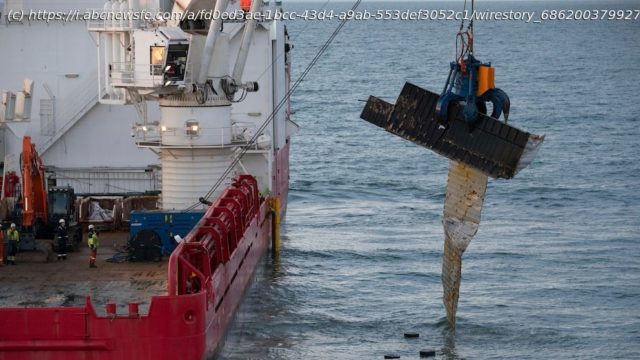Most of the world’s everyday goods and raw materials moved over long distances are packed in large metal boxes the size of tractor-trailers and stacked on ships
LONG Russ Lewis has picked up some strange things along the coast of Long Beach Peninsula in Washington state over the years: Hot Wheels bicycle helmets with feather tufts, life-size plastic turkey decoys made for hunters, colorful squirt guns.
And Crocs — so many mismatched Crocs.
If you find a single Croc shoe, you might think somebody lost it out on the beach, he said. “But, if you find two, three, four and they’re different — you know, one’s a big one, one’s a little one — that’s a clue.”
These items aren’t like the used fishing gear and beer cans that Lewis also finds tossed overboard by fishers or partygoers. They’re the detritus of commercial shipping containers lost in the open ocean.
Most of the world’s raw materials and everyday goods that are moved over long distances — from T-shirts to televisions, cellphones to hospital beds — are packed in large metal boxes the size of tractor-trailers and stacked on ships. A trade group says some 250 million containers cross the oceans every year — but not everything arrives as planned.
More than 20,000 shipping containers have tumbled overboard in the last decade and a half. Their varied contents have washed onto shorelines, poisoned fisheries and animal habitats, and added to swirling ocean trash vortexes. Most containers eventually sink to the sea floor and are never retrieved.
Cargo ships can lose anywhere from a single container to hundreds at a time in rough seas. Experts disagree on how many are lost each year. The World Shipping Council, an industry group, reports that, on average, about 1,500 were lost annually over the 16 years they’ve tracked — though fewer in recent years. Others say the real number is much higher, as the shipping council data doesn’t include the entire industry and there are no penalties for failing to report losses publicly.
Much of the debris that washed up on Lewis’ beach matched items lost off the giant cargo ship ONE Apus in November 2020. When the ship hit heavy swells on a voyage from China to California, nearly 2,000 containers slid into the Pacific.
Court documents and industry reports show the vessel was carrying more than $100,000 worth of bicycle helmets and thousands of cartons of Crocs, as well as electronics and other more hazardous goods: batteries, ethanol and 54 containers of fireworks.
Researchers mapped the flow of debris to several Pacific coastlines thousands of miles apart, including Lewis’ beach and the remote Midway Atoll, a national wildlife refuge for millions of seabirds near the Hawaiian Islands that also received a flood of mismatched Crocs.
Scientists and environmental advocates say more should be done to track losses and prevent container spills.
“Just because it may seem ‘out of sight, out of mind,’ doesn’t mean there aren’t vast environmental consequences,” said marine biologist Andrew DeVogelaere of California’s Monterey Bay National Marine Sanctuary, who has spent more than 15 years studying the environmental impact of a single container that was found in sanctuary waters.
“We are leaving time capsules on the bottom of the sea of everything we buy and sell — sitting down there for maybe hundreds of years,” he said.
This year’s summer winds washed thousands of plastic pellets ashore near Colombo, Sri Lanka, three years after a massive fire aboard the X-Press Pearl burned for days and sank the vessel a few miles offshore.
The disaster dumped more than 1,400 damaged shipping containers into the sea — releasing billions of plastic manufacturing pellets known as nurdles as well as thousands of tons of nitric acid, lead, methanol and sodium hydroxide, all toxic to marine life.
Hemantha Withanage remembers how the beach near his home smelled of burnt chemicals. Volunteers soon collected thousands of dead fish, gills stuffed with chemical-laced plastic, and nearly 400 dead endangered sea turtles, more than 40 dolphins and six whales, their mouths jammed with plastic. “It was like a war zone,” he said.
Cleanup crews wearing full-body hazmat suits strode into the tide with hand sieves to try to collect the lentil-size plastic pellets.
The waterfront was closed to commercial fishing for three months, and the 12,000 families that depend on fishing for their income have only gotten a fraction of the $72 million that Withanage, founder of Sri Lanka’s nonprofit Centre for Environmental Justice, believes they are owed.
“Just last week, there was a huge wind, and all the beaches were full of plastic again,” he said in mid-June.
Lost container contents don’t have to be toxic to wreak havoc.
Home
United States
USA — mix Thousands of shipping containers have been lost at sea. What happens when...






